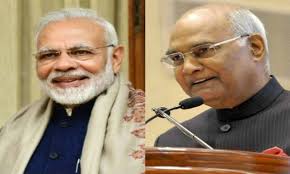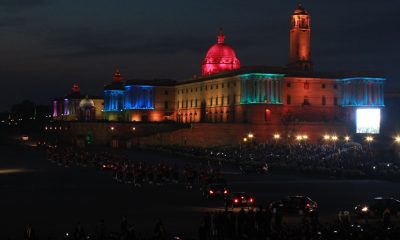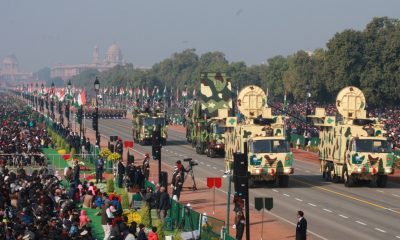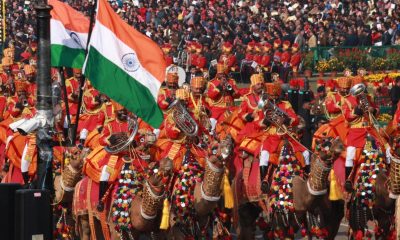Feature
Guard against intolerance, embrace consensus: President

 New Delhi:President Pranab Mukherjee on Monday urged Indians to shun “violence, intolerance and unreason” and said that decision making must be based on cooperation and consensus-building.
New Delhi:President Pranab Mukherjee on Monday urged Indians to shun “violence, intolerance and unreason” and said that decision making must be based on cooperation and consensus-building.
In his annual Republic Day eve address, the president also said that while rebellion was also a virtue of democracy, “let us also applaud what our democracy has achieved” since independence in 1947.
Saying reverence for the past was one of the essential ingredients of nationalism, he said that it was important to ensure that all citizens got justice, equality, and gender and economic equity.
“When grim instances of violence hit at these established values which are at the core of our nationhood, it is time to take note,” he said.
“We must guard ourselves against the forces of violence, intolerance and unreason.”
The president said that to revitalize the forces of growth, the country needed reforms and progressive legislation.
“It is the bounden duty of the law makers to ensure that such legislation is enacted after due discussion and debate.
“A spirit of accommodation, cooperation and consensus-building should be the preferred mode of decision-making.”
Saying no one nation could be an oasis of growth, he pointed out that India’s economy also faced the blowback. Nature was also unkind to India last year, he added, referring to drought and floods, affecting rural income and employment.
India, he said, was building and implementing strategies to solve these problems.
“This year, with an estimated growth rate of 7.3 percent, India is poised to become the fastest growing large economy. Contraction in global oil prices has helped maintain external sector stability and control domestic prices. Despite occasional setbacks, industrial performance this year has been strong.”
Mukherjee said there “will be, amongst us, occasional doubters and baiters. Let us continue to complain; to demand; to rebel. This too is a virtue of democracy.
“But let us also applaud what our democracy has achieved.”
He said with investments in infrastructure, manufacturing, health, education, science and technology, India was positioning itself to achieve a higher growth rate which in 10-15 years will help banish poverty.
The president said that as the 20th century ended with a remarkable revolution in science and technology, there were reasons for optimism that the 21st century would see the last of extreme poverty.
“That optimism has faded in the first 15 years of this century,” he said, adding the scourge of terrorism had reshaped war into its most barbaric manifestation.
“Terrorism is inspired by insane objectives, motivated by bottomless depths of hatred, instigated by puppeteers who have invested heavily in havoc through the mass murder of innocents.
“This is war beyond any doctrine, a cancer which must be operated out with a firm scalpel. There is no good or bad terrorism; it is pure evil.”
He said terrorists seek to undermine order by rejecting the very basis of strategic stability, “which are recognized borders. If outlaws are able to unravel borders, then we are heading towards an age of chaos”.
Without taking any country’s name, the president said that there were bound to be disputes among nations.
“As is well-known, the closer we are to a neighbour the higher the propensity for disputes. There is a civilized way to bridge disagreement; dialogue, ideally, should be a continual engagement.
“But we cannot discuss peace under a shower of bullets.”
The president lauded the many government schemes including Aadhaar, the Pradhan Mantri Jan Dhan Yojana, the Saansad Adarsh Gram Yojana, the Digital India programme, the Pradhan Mantri Fasal Bima Yojana and MGNREGA.
The Make-in-India campaign, he said, will boost manufacturing by facilitating easy conduct of business and improving competitiveness of domestic industry.
“The Start-up India programme will foster innovation and encourage new-age entrepreneurship. The National Skill Development Mission envisages skilling 300 million youth by 2022.”
The president ended his speech with Tagore’s immortal words:
Move ahead, the roll of drums announce your triumphal march;
With feet of glory, you shall cut out your own path;
Delay not, delay not, a new age dawns.
Entertainment
Meghalaya Reserves Legalized Gambling and Sports Betting for Tourists

The State Scores Extra High on Gaming-Friendly Industry Index
Meghalaya scored 92.85 out of 100 possible points in a Gaming Industry Index and proved to be India’s most gaming-friendly state following its recent profound legislation changes over the field allowing land-based and online gaming, including games of chance, under a licensing regime.
The index by the UK India Business Council (UKIBC) uses a scale of 0 to 100 to measure the level of legalisation on gambling and betting achieved by a state based on the scores over a set of seven different games – lottery, horse racing, betting on sports, poker, rummy, casino and fantasy sports
Starting from February last year, Meghalaya became the third state in India’s northeast to legalise gambling and betting after Sikkim and Nagaland. After consultations with the UKIBC, the state proceeded with the adoption of the Meghalaya Regulation of Gaming Act, 2021 and the nullification of the Meghalaya Prevention of Gambling Act, 1970. Subsequently in December, the Meghalaya Regulation of Gaming Rules, 2021 were notified and came into force.
All for the Tourists
The move to legalise and license various forms of offline and online betting and gambling in Meghalaya is aimed at boosting tourism and creating jobs, and altogether raising taxation revenues for the northeastern state. At the same time, the opportunities to bet and gamble legally will be reserved only for tourists and visitors.
“We came out with a Gaming Act and subsequently framed the Regulation of Gaming Rules, 2021. The government will accordingly issue licenses to operate games of skill and chance, both online and offline,” said James P. K. Sangma, Meghalaya State Law and Taxation Minister speaking in the capital city of Shillong. “But the legalized gambling and gaming will only be for tourists and not residents of Meghalaya,” he continued.
To be allowed to play, tourists and people visiting the state for work or business purposes will have to prove their non-resident status by presenting appropriate documents, in a process similar to a bank KYC (Know Your Customer) procedure.
Meghalaya Reaches Out to a Vast Market
With 140 millions of people in India estimated to bet regularly on sports, and a total of 370 million desi bettors around prominent sporting events, as per data from one of the latest reports by Esse N Videri, Meghalaya is set to reach out and take a piece of a vast market.
Estimates on the financial value of India’s sports betting market, combined across all types of offline channels and online sports and cricket predictions and betting platforms, speak about amounts between $130 and $150 billion (roughly between ₹9.7 and ₹11.5 lakh crore).
Andhra Pradesh, Telangana and Delhi are shown to deliver the highest number of bettors and Meghalaya can count on substantial tourists flow from their betting circles. The sports betting communities of Karnataka, Maharashtra, Uttar Pradesh and Haryana are also not to be underestimated.
Among the sports, cricket is most popular, registering 68 percent of the total bet count analyzed by Esse N Videri. Football takes second position with 11 percent of the bets, followed by betting on FIFA at 7 percent and on eCricket at 5 percent. The last position in the Top 5 of popular sports for betting in India is taken by tennis with 3 percent of the bet count.
Local Citizens will Still have Their Teer Betting
Meghalaya residents will still be permitted to participate in teer betting over arrow-shooting results. Teer is a traditional method of gambling, somewhat similar to a lottery draw, and held under the rules of the Meghalaya Regulation of the Game of Arrow Shooting and the Sale of Teer Tickets Act, 2018.
Teer includes bettors wagering on the number of arrows that reach the target which is placed about 50 meters away from a team of 20 archers positioned in a semicircle.
The archers shoot volleys of arrows at the target for ten minutes, and players place their bets choosing a number between 0 and 99 trying to guess the last two digits of the number of arrows that successfully pierce the target.
If, for example, the number of hits is 256, anyone who has bet on 56 wins an amount eight times bigger than their wager.























